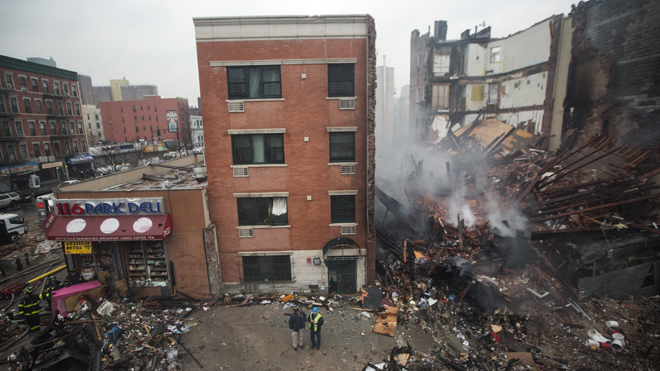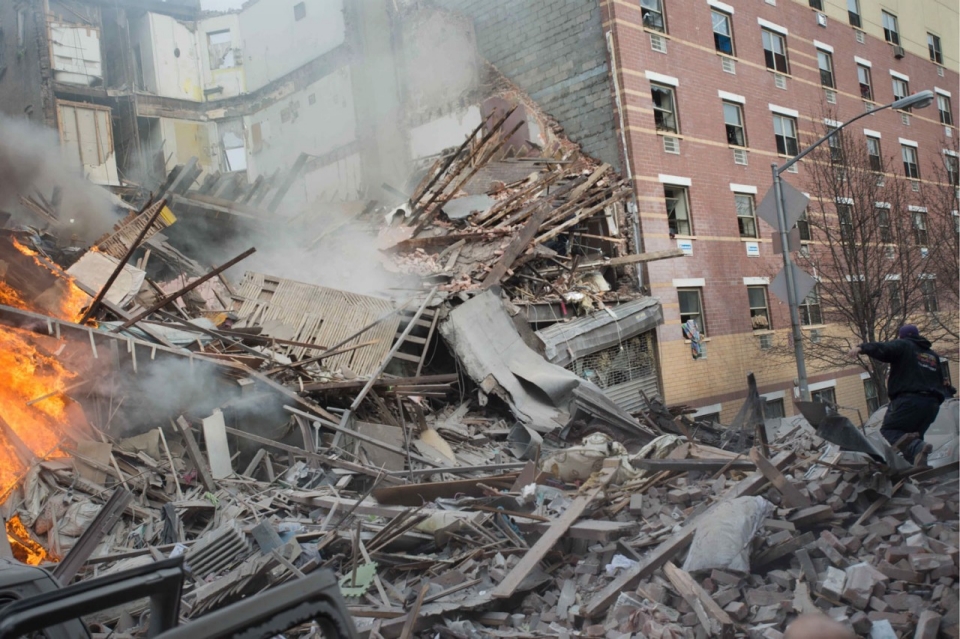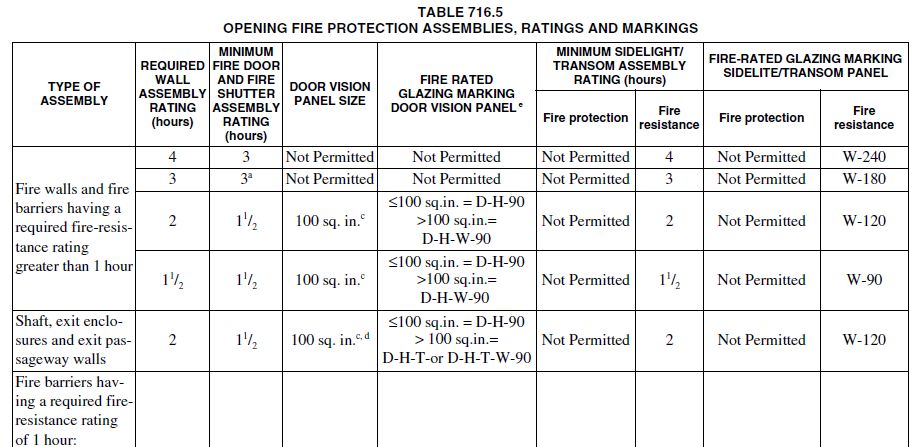 You may have heard about last week’s explosion which leveled two Manhattan apartment buildings, leaving 8 people dead, more than 60 injured, and more than 100 displaced from their homes. The buildings also housed a church and a piano store on the lower levels (before and after photos here).
You may have heard about last week’s explosion which leveled two Manhattan apartment buildings, leaving 8 people dead, more than 60 injured, and more than 100 displaced from their homes. The buildings also housed a church and a piano store on the lower levels (before and after photos here).
Photos of the collapsed buildings show what appear to be fire walls between each of the adjoining buildings, which may have provided some protection from the explosion and resulting fire. The term “fire wall” is often misused as meaning any wall that has a fire resistance rating, but a fire wall is different from a fire barrier or a fire partition (I’ll talk about those in future posts).
The International Building Code (IBC) defines a fire wall as, “A fire-resistance-rated wall having protected openings, which restricts the spread of fire and extends continuously from the foundation to or through the roof, with sufficient structural stability under fire conditions to allow collapse of construction on either side without collapse of the wall.”
 Fire walls may divide a structure into separate “buildings” or fire areas – extending from the foundation to/through the roof, and must be constructed so the wall will remain in place if the construction on either side of the wall collapses. Section 706 of the 2012 IBC addresses the requirements for fire walls, which are much more restrictive than the requirements for fire barriers or fire partitions.
Fire walls may divide a structure into separate “buildings” or fire areas – extending from the foundation to/through the roof, and must be constructed so the wall will remain in place if the construction on either side of the wall collapses. Section 706 of the 2012 IBC addresses the requirements for fire walls, which are much more restrictive than the requirements for fire barriers or fire partitions.
According to Table 706.4 (2012 IBC), fire walls may be rated for 2, 3, or 4 hours, depending on the use group / occupancy type. For example, a fire wall in a Mercantile use group would have a rating of 3 hours, while a fire wall between dwelling units in a boarding house (Group R-3) or assisted living facility (Group R-4) must be rated for 2 hours of fire resistance.
Because of the required fire performance, each opening through a fire wall is limited to 156 square feet, and the total width of all openings on any floor level may not be more than 25 percent of the length of the fire wall. If the buildings on both sides of the fire wall are fully sprinklered, the limitation of 156 square feet per opening does not apply, but the total length of all openings per floor level is still limited to 25 percent of the wall length.
Table 716.5 (IBC 2012), shows the required ratings of the fire door assemblies in fire walls (note that this is only a small portion of Table 716.5). Some doors with a fire rating of 3 hours will require special considerations when specifying the hardware, so it’s best to confirm hardware requirements with the manufacturers of the fire door assembly.
More to follow on fire barriers and fire partitions…for more in-depth information on fire walls, refer to this article by Ron Geren.
A fire wall was also credited for helping to protect a portion of the building in the recent senior living home in L’Isle Verte.
Photos: Fox News, Jeremy Smalling/AP.
You need to login or register to bookmark/favorite this content.






The IBC is not unique in differentiating between fire walls and fire separations. Older building codes in Europe have similar considerations, particularly in urban areas with zero lotline or party wall conditions. Both the National Building Code of Canada (NBCC) and the Ontario Building Code (OBC) carry the following definition – “Firewall means a type of fire separation of non-combustible construction that subdivides a building or separates adjoining buildings to resist the spread of fire and that has a fire-resistance rating as prescribed in this code and the structural ability to remain intact under fire conditions for the required fire rated time”. In the past we have divided school buildings with fire walls to have unsprinklered compartments of non combustible construction. Many of these were constructed to achieve a 4 hour rating through the use of two -two hour rated assemblies attached to each compartment or building. The challenge was fitting the doors in the corridors in such a way that provided protection from collapse to both sides. The solution was to construct an independent portal frame that was structurally isolated from both the compartments or buildings on both sides. The portal frame created the appropriate structure on several floors that maintained the integrity of the doors while allowing the structures on either side to collapse in a fire condition.
JRD
Fantastic!!